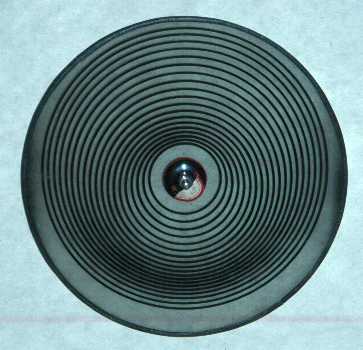Starting at the top and working down, the various forms represent:
| The wave machine at the right is in the collection
of Union College in Schenectady, New York. It is listed at $15.00 in the 1929
Central Scientific Company catalogue as the Waggener Wave Apparatus. W. J.
Waggoner was a former professor at the University of Colorado, and developed
it in early 1895 while a student at the University of Berlin.
Starting at the top and working down, the various forms represent: |
The example at the right is in the collection of the physics department of the University of Vermont. |
And, this one is at Case Western Reserve University in Cleveland. |
| The device at the right was probably used in
conjunction with an arc light to cast shadows of the wires onto a flat wall;
it is not the typical rectangular shape of apparatus used in a projector,
and does not show wear marks from the projector gate.
It is in the West Point collection. The device appears to be similar to the motorized version below that was made by Gaertner of Chicago. |
|
|
This wave demonstrator was made by Gaertner of Chicago,
and is in the Demonstration Room of the University of Texas at Austin.
The apparatus is still in use, and had a slow speed motor attached at one time to drive it. |
| When this wave demonstrator by Gaertner first
came to me, it was held in a plywood frame that enabled it to be used in a
lantern-slide projector. This was removed, and a good deal of hard masking tape was carefully removed. |
|
B. Simple Harmonic Motion Demonstrator for Use in Projectors. The Demonstration Slide for Simple Harmonic Motion shown below is in the apparatus collection of the University of Vermont. It is shown in the 1928 Central Scientific Company catalogue at a price of $60, making it a relatively expensive piece of apparatus for the time.
The apparatus, developed at the Department of Physics at the University of Minnesota, is designed to fit into the gate of a 3¼ by 4 inch lantern slide projector. Turning the crank causes a dot to travel around the rim of the circle at a constant angular speed, while a second dot, located at the horizontal component of the displacement of the first dot, moves backward and forward in Simple Harmonic Motion. The crank may either be turned by hand or with a slow-speed motor.
C. Wave Disks for Use in Projectors. This incomplete wave disk at the Wesleyan University in Middletown, Connecticut is missing its drive cord, and also the slit used to define the line of the wave. A good many animated projection devices from the 19th century used the same mechanism.
C. Max Kohl Shadow-Projection Templates. These are listed in the 1900 Max Kohl catalogue as a "Projection-wave machine with 4 round and 2 square photographic plates" at a cost of 40 marks. Both Virginia Military Institute and Kenyon College have full sets surviving.
|
|

|
Kenyon College
REF: Thomas B. Greenslade, Jr., "Apparatus for Natural Philosophy: Nineteenth
Century Wave Machines", Phys. Teach., 18, 510-517 (1980)
Return to Oscillations and Waves Home Page | Return to Home Page